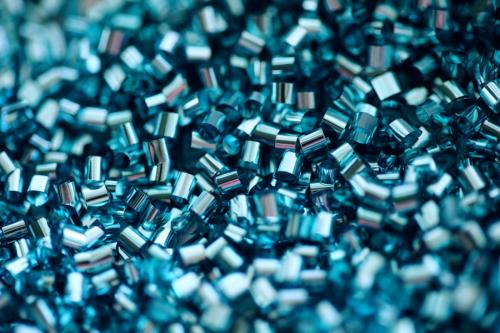Although we oftentimes take them for granted, plastics — and the products that are made from them — have become essential in virtually all aspects of our lives.
The plastics industry is, in fact, one of the largest manufacturing industries in the world, with the U.S. sector alone generating over $450 billion per year in shipments. However, the environmental impact of this industry cannot be ignored and in recent years, the demand for recycled plastic material (and the necessary processing solutions) has risen dramatically.
When it comes to the dry bulk handling of recycled plastic material, there are actually quite a few steps and factors that need to be considered. From the collection and sorting of plastic waste to the eventual reprocessing and repackaging after the recycling procedures . . . dry bulk handling equipment can be used every step of the way to expedite the process.
Taking all of that into consideration, here's everything that you need to know about the dry bulk handling of recycled plastic material.
How Are Plastics Created?
When it comes to how they are produced, plastics can be divided into two broad categories based on the materials that are used in their creation: synthetic and biobased.
Biobased plastics (as their name suggests) are generally created using renewable biological substances, such as vegetable fats and oils, carbohydrates, starch, and even bacteria.
Synthetic plastics, on the other hand, are what most of us think of when the topic of plastic production comes up. Synthetic plastics are generally produced using crude oil, natural gas, or coal.
An Overview Of The Plastic Creation Process
The end result may seem fairly simple compared to other manufacturing industries, but the plastic creation process is actually incredibly intricate and complex. Here is a brief overview of the key steps in the process, from start to finish.
- It begins with the use of raw materials — such as crude oil or natural gas. These materials are subsequently refined to produce ethane and propane.
- A process called "cracking" is used to treat the ethane and propane with high heat. It converts them into monomers (ethylene and propylene).
- The monomers are then combined with a catalyst, fed into an extruder, and then subjected to high heat until they melt.
- Once the process is completed, the plastic is then usually sent through pipes where it eventually takes the form of a long tube as it cools.
- The plastic is then cut into varying sizes (usually relatively small pellets) and shipped to other factories where it can be melted and molded into end products (bottles, mechanical parts, packaging, etc.)
The Plastic Recycling Process — How Is Recycled Plastic Material Created?
Plastics Recycling — Collection
The first part of the plastic recycling process is also the most straightforward. The plastics that we use and then subsequently dispose of — whether on a personal or a commercial level — are collected from our communities or businesses. This collection of plastic waste can either be carried out by a government entity or by private haulers.
Although the general gist of the plastic collection process remains the same throughout the world, there are still aspects that will vary between countries and even between states (and municipalities).
Plastics Recycling — Sorting
In many parts of the world, it is often recommended that consumers sort their waste — either from their homes or businesses — into broad categories like organic, inorganic, paper, plastic, etc.
Even after all of that, there is still a lot of intricate sorting that needs to take place at specialized facilities under the supervision of professionals. At plastics recycling facilities, items are first sorted into groups based on their "plastic type". This is an essential step that prevents the cross-contamination of polymers — which if left unchecked would hinder the reprocessing efforts.
Advanced plastic waste recycling machine manufacturers have also designed specialized equipment that can actually recognize the unique signature of specific polymers. Other factors like color and the presence of impurities or contaminants can also be identified using infrared, x-ray, and similar types of technological sensors.
Plastics Recycling — Reprocessing
The first step of plastic reprocessing is resizing — breaking down the waste so that it is easier to handle and reshape. In industrial plastic recycling facilities, this is primarily done using shredders and granulators that have rotational cutting blades.
Once the grinding is completed, the plastic shreds are sorted (and checked one last time for impurities) and then put through a process called compounding. This process generally involves the melting, recombining, and then finally reshaping of the plastic into a pellet-like form.These pellets are the most common type of recycled plastic material handled by dry bulk equipment.
Recycled Plastic Material And The Recycled Plastic Products That Can Be Created
Most plastic products can be recycled to some extent; however, there are varying degrees of time and effort that need to be put in depending on the shape, composition, and density. Some of the worst offenders in this regard are plastic bags, due to how thin and flexible they are. As a result of this, plastic bags are often viewed as being "unrecyclable" but this is not true, they simply require highly specialized equipment with a great deal of precision.
The majority of plastic products that end up being put through the recycling process, however, are bottles — whether they be drink bottles (soda, juice, milk, etc.), hygiene products, cleaning supplies, etc.
Here are some examples of products that are made from recycled plastic:
- Bottles
- Packaging
- Bags
- Carpets
- Building materials
- Furniture
- Automobile parts
- Clothing
Industrial Plastic Recycling — Dry Bulk Handling Equipment Used In Sorting
There is a wide variety of dry bulk handling equipment that can be used at virtually every step of the plastic recycling process to either perform a necessary function or to simply improve efficiency and productivity.
Here are a few examples of the equipment that is commonly used in the sorting of plastics.
Conveyors — Flexible screw conveyors and vibratory conveyors are ideal for the efficient moving of bulk recycled plastic material in a gentle and consistent manner. High-quality conveyors are viewed as the backbone or foundation of the plastic recycling process.
Air Separators — These are primarily used to remove lightweight contaminants, such as paper or cardboard, from the stream of plastics (which are generally heavier) that are to be recycled.
Trommels — These are slowly rotating machines (usually about 5–10 rotations per minute) that utilize a cylindrical mesh screen tunnel to separate relatively small contaminants from recyclables.
Disk Separators — These machines separate plastics by size and utilize jagged disks (moved by rotors) that are oriented vertically and have predetermined gap sizes. This facilitates a process whereby the larger material stays on top of the disks while the smaller material passes through the gaps.
Industrial Plastic Recycling — Dry Bulk Handling Used In Reprocessing
When it comes to the reprocessing of recycled plastic material, there are two main steps that take place before we get to the end product — shredding/granulating and pelletizing.
Here are a few examples of the equipment that is commonly used in the reprocessing of plastics.
Plastic Shredders — Once plastic waste products have gone through the sorting process, they then need to be broken down so that they are easier to handle. Depending on your specifications and needs, plastic shredders are capable of breaking down plastics into a wide range of sizes. In addition to this, specialized equipment is often used for specific types of plastic products; for example plastic film shredders for plastic bags and other flexible plastic films.
Plastic Granulators — These machines are sometimes referred to as "plastic crushers" and their purpose is to break down shredded plastic into uniform streams of small flakes or "regrinds". The uniformity of the granulating process is vital because it improves the efficacy and efficiency of the recombining process.
Plastic Pelletizers — After they are processed, plastics are generally compressed into a pellet-like form before they are shipped to facilities that create specific products (bottles, mechanical parts, etc.) . . . this is true for both new and recycled plastics. Pelletizers take the plastic regrind, melt it down, feed it through extruders and degassing systems, and then produce pellets that can be further shaped as needed.
Bulk Bag Fillers — Due to the relatively small nature of the plastic pellets, specialized equipment is often used to prevent waste and expedite the packaging process. Bulk bag fillers are low-cost solutions that meet all of these needs and can be applied in both semi-automatic and automatic systems.
Recycled Plastic Material Handling Solutions From ETS
Erie Technical Solutions are plastic waste recycling machine manufacturers that are committed to pushing the boundaries of innovation and productivity in the plastic recycling industry. These specialized machines and equipment are targeted toward eliminating waste and improving the overall functionality of your company's recycling systems.
Don't wait, contact Erie Technical Solutions so that you can get started on streamlining the effectiveness and efficiency of your plastics recycling systems today!

